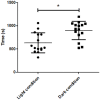Effect of illumination level [18F]FDG-PET brain uptake in free moving mice
- PMID: 33984015
- PMCID: PMC8118315
- DOI: 10.1371/journal.pone.0251454
Effect of illumination level [18F]FDG-PET brain uptake in free moving mice
Abstract
In both clinical and preclinical scenarios, 2-deoxy-2[18F]fluoro-D-glucose ([18F]FDG) is the radiotracer most widely used to study brain glucose metabolism with positron emission tomography (PET). In clinical practice, there is a worldwide standardized protocol for preparing patients for [18F]FDG-PET studies, which specifies the room lighting. However, this standard is typically not observed in the preclinical field, although it is well known that animal handling affects the biodistribution of [18F]FDG. The present study aimed to evaluate the effect of ambient lighting on brain [18F]FDG uptake in mice. Two [18F]FDG-PET studies were performed on each animal, one in light and one in dark conditions. Thermal video recordings were acquired to analyse animal motor activity in both conditions. [18F]FDG-PET images were analysed with the Statistical Parametric Mapping method. The results showed that [18F]FDG uptake is higher in darkness than in light condition in mouse nucleus accumbens, hippocampus, midbrain, hindbrain, and cerebellum. The SPM analysis also showed an interaction between the illumination condition and the sex of the animal. Mouse activity was significantly different (p = 0.01) between light conditions (632 ± 215 s of movement) and dark conditions (989 ± 200 s), without significant effect of sex (p = 0.416). We concluded that room illumination conditions during [18F]FDG uptake in mice affected the brain [18F]FDG biodistribution. Therefore, we highlight the importance to control this factor to ensure more reliable and reproducible mouse brain [18F]FDG-PET results.
Conflict of interest statement
The authors have declared that no competing interests exist.
Figures



Similar articles
-
The impact of different 18FDG PET healthy subject scans for comparison with single patient in SPM analysis.Q J Nucl Med Mol Imaging. 2017 Mar;61(1):115-132. doi: 10.23736/S1824-4785.16.02749-7. Epub 2014 Dec 5. Q J Nucl Med Mol Imaging. 2017. PMID: 25479418
-
Choice of anesthesia and data analysis method strongly increases sensitivity of 18F-FDG PET imaging during experimental epileptogenesis.PLoS One. 2021 Nov 24;16(11):e0260482. doi: 10.1371/journal.pone.0260482. eCollection 2021. PLoS One. 2021. PMID: 34818362 Free PMC article.
-
The use of 18F-Fluoro-deoxy-glucose positron emission tomography (18F-FDG PET) as a non-invasive pharmacodynamic biomarker to determine the minimally pharmacologically active dose of AZD8835, a novel PI3Kα inhibitor.PLoS One. 2017 Aug 14;12(8):e0183048. doi: 10.1371/journal.pone.0183048. eCollection 2017. PLoS One. 2017. PMID: 28806782 Free PMC article.
-
[The value of 18F-fluoro-2-deoxy-D-glucose positron emission tomography (18F-FDG PET) in diagnosis of neoplastic diseases].Med Clin (Barc). 2005 Feb 19;124(6):229-36. doi: 10.1157/13071769. Med Clin (Barc). 2005. PMID: 15737307 Review. Spanish.
-
Clinical applications and advances of positron emission tomography with fluorine-18-fluorodeoxyglucose (18F-FDG) in the diagnosis of liver neoplasms.Postgrad Med J. 2008 May;84(991):246-51. doi: 10.1136/pgmj.2007.066589. Postgrad Med J. 2008. PMID: 18508981 Review.
References
Publication types
MeSH terms
Substances
LinkOut - more resources
Full Text Sources
Other Literature Sources

